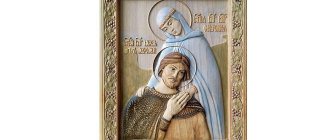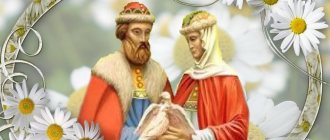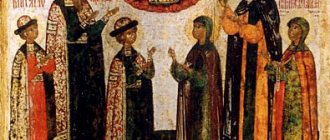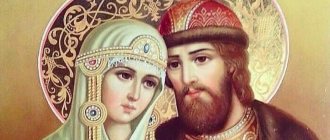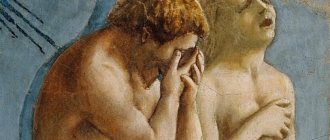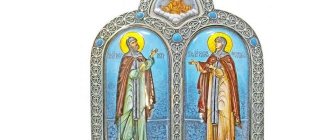- Essays
- On literature
- Other
- Analysis of the Tale of Peter and Fevronia of Murom
The work was created by the priest Ermolai-Erasmus on the instructions of Metropolitan Macarius with the aim of collecting legends about Russian people who became famous by committing pious deeds, becoming one of the symbols of happy Christian families, subsequently proclaimed saints by the church council and canonized.
The storyline of the story is built on the narrative of a folk legend, the heroine of which is a wise peasant girl who became a princess.
The structure of the work consists of two parts, the first of which tells about the principality of Prince Paul. The serpent-tempter begins to fly to the prince's wife as a rapist. The prince and his wife begin to look for a way to get rid of the serpent and learn that he could die from the blow of Agrikov’s sword. Peter, who is the brother of Prince Paul, is called upon to perform this act, having obtained the necessary weapon in the form of a treasure sword from among the cemetery slabs. In the battle with the serpent, Peter kills the rapist, but finds himself completely splashed with witchcraft blood, which is why the hero’s body becomes covered with scabs from an incurable disease.
Peter is cured of a terrible illness by a maiden called Fevronya, who became the prince’s wife, who is characterized by the narrator as a person ready for self-sacrifice, possessing wisdom, enormous inner strength and true feelings. A woman is distinguished by the life-giving power of love, capable of reading the thoughts of others with her strong spirit.
The spouses, having lived a long happy life, sensing their approaching death, begin to pray to God for a joint death on the same day, taking monastic vows and preparing a common burial. While in the convent, Fevronia, at the moment of embroidering the cloth intended for the Mother of God, receives Peter's messages one after another about his imminent death and begs her husband to give her the opportunity to finish work on the robe of the shrine. However, having heard the third call of her husband, Fevronia puts aside her embroidery and goes to Peter to die at the same time.
The burial of the spouses is carried out in separate coffins, but with the onset of the next day, the deceased Peter and Fevronia find themselves together in a coffin, which was prepared for a joint burial. All attempts to separate the bodies of deceased spouses will not be successful.
The example of love and loyalty of the family of Fevronia and Peter, described in the work, is the ideal of selfless, devoted marital feelings.
Analysis 2
A work about marital love written by the sixteenth-century church writer Ermolai-Erasmus was very popular in its time.
The story, despite the presence of an author, is a retelling of folklore. Murom prince Peter falls ill when the blood of a fiery serpent falls on him. The serpent was killed with an Agric sword, which is also a folklore element, but, in this case, the authors of the tales processed by Ermolai-Erasmus tried to reconcile Christian and pagan elements. The same role is represented by the plot about the prince and princess accepting monasticism shortly before their death. The weapon that could be used to kill the snake was taken from the monastery church, and a church servant told Peter about its location.
The healing of Prince Peter by Fevronia also occurs in a supernatural way. Although she forced him to fulfill her promise to marry, using a fairly simple trick when prescribing treatment.
The story of an unequal marriage between a ruling prince and a peasant woman contains the international and timeless plot of Cinderella. Fevronia is shown in the Legend as a wise and faithful wife, as evidenced by her riddles.
The enemies of the faithful spouses are the Murom boyars, who did not want a princess of low birth. Such negative characters were also supposed to contribute to the growth of the popularity of the legend. The monarchical consciousness sees in the prince (and in this case, his wife, acting in conjunction with him) a natural ally capable of punishing the rich and powerful. The detail about the unrest between the boyars that flared up without Peter and Fevronia, when each tried to take the throne, is implausible. Only a certain narrow circle of people had the right to it, therefore, the legends underlying the Tale come from among the common people.
Peter renounces power and leaves the city together with Fevronia, and at the end of the story they die at the same time, since they cannot live without each other. This and similar plots of the Tale should have attracted readers, most of whom had family problems, but who wanted to hear about the ideal at least once again.
The legend about the fictional Murom prince and princess gained popularity due to the ineradicable need of people to believe in miracles and true true love.
The ideological content of “The Tale of Peter and Fevronia of Murom”
“The Tale of Peter and Fevronia of Murom” was written by a native of Pskov, archpriest of the palace cathedral in Moscow, and later by the monk Ermolai-Erasmus. But this text was not included in the code, because in many ways it differed from the classical hagiographic tradition. The thoughts expressed in “The Tale of Peter and Fevronia of Murom” about the meaning of human dignity are consonant with the ideas of humanists. “The Tale of Peter and Fevronia of Murom” is often called a hagiography, but instead of religious exploits, it is a story about the love of a peasant girl and the Murom prince. The work uses two motifs: the tale of a fiery flying serpent and the tale of a wise maiden.
In “The Tale of Peter and Fevronia” there is no indication of the actual historical prototypes of the heroes.
The author describes the real events that made it possible to canonize and then canonize Prince Peter and Princess Fevronia. In the construction of the story there are many details characteristic of a fairy-tale narrative.
The snake is the embodiment of evil, evil spirits. This image is widely used in many Russian folk tales and epics. The serpent tempting Peter's wife is sent by the devil, and this moment recalls the fall of Eve, who was also tempted by the serpent-devil.
But in fairy tales, the fight against the snake is the basis of the story; the entire plot is based on showing the victory of the fairy-tale hero over the snake. In this work, the victory over the serpent only introduces the reader at the beginning of the story to Prince Peter and shows him as a brave and strong warrior.
The wise beauty Fevronia is also partly a fairy-tale heroine. She is wise, knows how to work miracles, guess other people's thoughts. The appearance of a peasant girl who healed Peter from the scabs that covered his body from the serpent’s blood splashed on him introduces into the narrative the tradition of fairy tales about a beautiful maiden, striking in her purity and wisdom. The author somehow especially shows her in his work: “a girl sat alone at a weaving mill and weaved canvas, and a hare galloped in front of her.” This animal in folklore serves as a symbol of marriage, and it can be considered a wise riddle of the author himself. At the same time, this detail can be interpreted as the heroine’s immersion in the natural world.
Fevronia’s agreement to heal Peter on the condition of marrying her can be interpreted in two ways: as the fairy-tale heroine’s desire to achieve happiness and as the saint’s prediction of her future fate.
The author repeatedly uses such a fabulous technique as telling fairy tales. It is with this riddle that one of the young warriors begins to meet Princess Fevronia when he comes to ask for healing for Peter. Fevronia does not attach mystical significance to solving riddles; she shows herself to be a wise girl who knows how to speak allegorically. Peter failed to recognize Fevronia’s last little trick. Fulfilling all the instructions of his healer, he doomed himself to return to Ryazan Laskovo.
Many episodes of “The Tale of Peter and Fevronia...” speak about the intelligence of this woman, her ability to be both a faithful wife and a wise princess.
After the wedding, Prince Peter and Princess Fevronia will live a long and happy life, giving others kindness, love, warmth and generosity of their souls. As in a fairy tale, they will die on the same day, marking the beginning of their immortal existence in the memory of grateful people.
Love in “The Tale of Peter and Fevronia” is least of all an all-consuming human passion. Fevronia's love for Prince Peter is invincible precisely because it has already been internally defeated by herself, subordinated to her mind. The theme of love is closely related to the theme of human wisdom, one of the main ones in ancient Russian literature. “They had equal love for everyone, did not like cruelty and money-grubbing, did not spare perishable wealth, but grew rich in God’s wealth.”
The ending of the story is also traditional for life, when Peter and Fevronia, before their death, take monasticism under the name of David and Euphrosyne. They remained faithful to each other in secular and monastic life, not only “to the grave”, but also “beyond the grave”: “and after that they no longer dared to touch their holy bodies and buried them near the city cathedral church of the Nativity of the Holy Mother of God... Those who fell in faith to in the cancer with their relics they generously receive healing.”
The legends told in the story of Peter and Fevronia have much in common with Western European stories. The work is highly artistic and poetic. In the story there are no indications of the actual historical prototypes of the heroes.
A number of aspects of “The Tale of Peter and Fevronia” make it similar to different types of folk fairy tales. This is both the heroine’s closeness to the natural world and her allegorical speech. The author spreads the riddles and solutions over time: only in response to the bewilderment of the young man does Fevronia explain: the ears of the house are a dog, and the eyes are a child; to cry on loan means to go to a funeral; looking death in the face through your legs - beekeeping, i.e. collecting honey from trees.
The author connects his story with hagiographic legends about Murom saints. The miracles in the story are unusual: the boyars' wives complain about the petty behavior of the Murom princess, seeing this as a consequence of her peasant origin. But the crumbs in Fevronia’s hand undergo a special change: the bread crumbs turn into incense and incense used in Orthodox worship. With Fevronia’s blessing, the twigs she stuck into the ground turn into flowering trees overnight. The author, thus, tries to show the life-giving power of her love. The husband's three-fold call to fulfill his promise to accept death together performs the function of a miracle.
The narrator ends the story with a prayer to Peter and Fevronia: “Rejoice, Peter, for you have been given by God the power to kill the flying fierce serpent! Rejoice, Fevronia, for in your woman’s head was the wisdom of holy men!.. Rejoice, honest leaders, for in your reign you lived with humility, in prayers, doing alms, without being arrogant; For this, Christ has overshadowed you with His grace, so that even after death your bodies lie inseparably in one tomb, and in spirit you stand before the Lord Christ! Rejoice, reverend and blessed ones, for even after death you invisibly heal those who come to you with faith!..”
The narrator shows that Fevronia, in the strength of her love and in her wisdom, turns out to be superior to her husband. However, not only is wisdom inherent in love, but love is also inherent in wisdom. There is no conflict, no struggle, no contradiction between feeling, mind and will...
The dying gesture of Fevronia, who at that time was embroidering “holy air” - a coverlet for vessels with communion, is also delightful. She “had not yet finished finishing one saint’s mantle, but had already embroidered his face; and she stopped, and stuck her needle in the air, and wound the thread with which she was embroidering around it. And she sent to tell blessed Peter, named David, that she was dying with him.” In those conditions when not much space is given to details in literature, Fevronia’s gesture is as precious as the gold embroidery that she sewed for the holy cup.
The element of folklore introduced everyday concreteness into the text of the story, which is unusual in contemporary literary monuments.
Wisdom is not just the ability to think logically and reflect, but something that is given by God himself. This is a combination of human reason and God's plan, something that can only act for the benefit of man, although he himself often does not understand this. This is exactly how Fevronia acted. The story says that she had the gift of clairvoyance, that is, foresight, which means she had wisdom from God. Here is how the author writes about it: “A certain man sailed in the same ship with Fevronia, whose wife was on the same ship. And the man, tempted by the evil demon, looked at the saint with thoughts. She, immediately guessing his evil thoughts, denounced him.”
It is not for nothing that Fevronia and Peter are called saints and wonderworkers. Perhaps, when she asked the prince to take her as his wife, she herself did not yet know that it would be for the good of both of them, but her wisdom told her how to act. But then Peter lives with Fevronia as if in Christ’s bosom and values his wife more and more. Peter is very grateful to God for such a wife, and when the boyars and nobles asked him to choose between his wife and the throne, he chose her: “This blessed prince acted according to the Gospel: he neglected his reign, so as not to violate the commandments of God...”
Material created: 12/28/2016
The language of spiritual Russian literature
Russian reality in Leskov’s story “Old Genius”
At the crossroads
Researchers agree: despite the legendary and allegorical story of Peter and Fevronia’s acquaintance, the information telling about their life after the wedding is quite reliable. And therefore, with one degree or another of probability, the events described in the second part of the “Tale” can be considered biographical.
Another evidence of this can be the fact that there is nothing out of the ordinary in the biography of the spouses. On the contrary, their lives are close to most of us, and therefore their story will never lose its relevance.
From an everyday point of view, there was only one truly difficult moment in the fate of Peter and Fevronia. Immediately after the wedding, Prince Peter is faced with a dilemma: his young wife or everything else that happened in his life. Marrying a peasant woman does not find support among the urban elite of Murom. The boyars openly declare this, first to the prince, and then to Fevronia herself. They offer the prince a choice: renunciation of his title (which means exile and poverty) or dissolution of the marriage.
Prince Peter finds it hard to bear what is happening; he looks with horror at the future, where the unknown awaits him... but, nevertheless, he makes a choice in favor of his wife. From now on, he is no longer a prince, and together with his wife he must go into exile. The spouses are being transported on a boat along the Oka River away from Murom...
This story is resolved unexpectedly quickly and safely. It turns out that Prince Peter was a key figure in the political life of the influential city. The struggle for power begins immediately; on the first night after his abdication, representatives of the boyar clans try to launch a preemptive strike on their opponents, which develops into a massacre. Realizing that all this could end in unrest and civil war, the rulers of Murom call the prince back.
From now on, the question of his “unequal marriage” does not arise...
The main thing in this episode is the reasons for the choice made by the spouses. Peter does not assert “the primacy of the personal over the public,” but simply follows in his actions the Christian law of love and mercy. In a difficult situation, when one can try to cheat or obey rational, selfish considerations, the prince obeys the law of the heart. His wife was given to him by God, and he cannot go against the will of God. The prince is not looking for personal benefit, profit, but is trying to follow the path that leads him - together with his wife - to the Creator. Therefore, he relies on God, who gave him a wife and in whom he trusts completely.
On the first day of exile, a dialogue took place between the spouses, which is given in the Tale. “Evening was approaching and we began to approach the shore. Here blessed Prince Peter was overcome with thoughts: “How will I continue to live, having left the autocracy by my own will?” The devoted princess Fevronia answers him: “Do not grieve, prince: the merciful God, the Creator and Provider of everything, will not leave us in poverty!”
They trust in God and believe in Him - this is the most “unmodern”, but the most important characteristic of their relationship. Spouses are always guided not by selfishness and the search for what is convenient for themselves, but by faith and hope in the One who gave them life and blessed their marriage.
Plot and theme of the chronicle
The theme is a description of the life of Prince Peter and his wife Fevronia. It tells in detail about their fate and the trials that awaited them.
The plot of the chronicle combines two parts. The first tells about the struggle of a prince with a snake, and the second about a young, beautiful girl who marries a difficult person and trials await her. Folklore is also noticeable in the plot, complementing the story. All events take place in the city of Murom, when the prince left home, a snake flew to his wife. The man thought about how to save his wife, and instructed her to extract his weaknesses from the snake, and so they learned how to kill the snake. He could have died from Peter’s shoulder and Agrikov’s sword. Peter’s brother was the prince and he also found the sword. There was only one problem left, the serpent knew how to turn into Peter. But when Peter killed the serpent, the blood got on him, and he fell ill with leprosy. The prince had a dream that Fevronia could cure her brother, and they turned to her for help, Fevronia agreed, but named her condition - Peter had to marry her, the prince agreed, but wanted to break his promise. Fevronia had foreseen such a situation, so she did not completely cure Peter, and the disease spread again. When the prince realized that there was no other choice, he kept his promise, Peter and Fevronia got married. They lived together and ruled together and died on the same day as they wanted.
